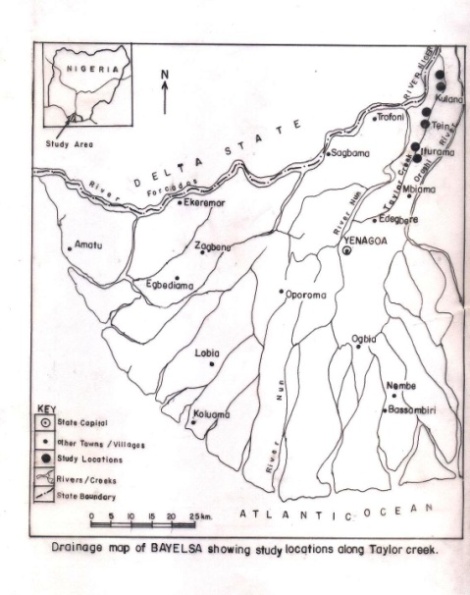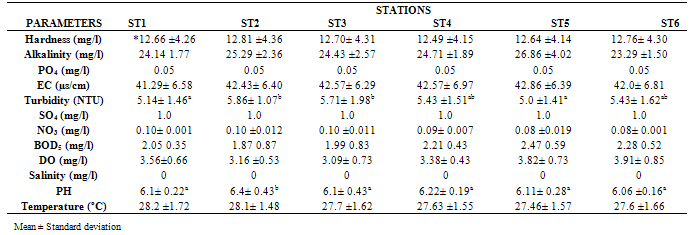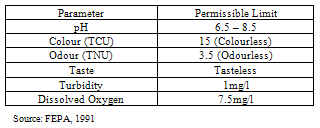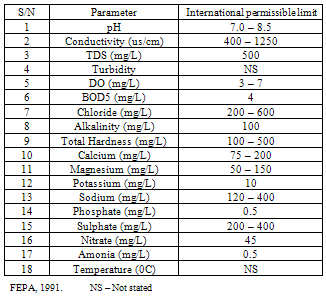-
Paper Information
- Previous Paper
- Paper Submission
-
Journal Information
- About This Journal
- Editorial Board
- Current Issue
- Archive
- Author Guidelines
- Contact Us
Resources and Environment
p-ISSN: 2163-2618 e-ISSN: 2163-2634
2012; 2(2): 45-50
doi: 10.5923/j.re.20120202.07
Human Induced Variations of Selected Physicochemical Parameters of Taylor Creek in the Niger Delta, Bayelsa State, Nigeria
Alagoa K. J 1, Aleleye-Wokoma I. P. 2
1Department of Agricultural Sciences,Bayelsa State College of Education,Okpoama, Brass Island. Bayelsa State
2Department of Animal and Environmental Biology,University of Port Harcourt,Port Harcourt
Correspondence to: Alagoa K. J , Department of Agricultural Sciences,Bayelsa State College of Education,Okpoama, Brass Island. Bayelsa State.
| Email: |  |
Copyright © 2012 Scientific & Academic Publishing. All Rights Reserved.
The physicochemistry of Taylor creek, Biseni, Bayelsa State was investigated in order to gauge the impact of human activities along the creek catchments on the creek integrity. Physicochemical parameters were investigated for one year, from November 2009 to October 2010. The creek was divided into six sampling zones located at Iturama, Tien and Kalama all in Biseni clan. Sampling was done monthly taking water samples. The physicochemical parameters investigated are pH, Electrical conductivity (EC), salinity, temperature, Alkalinity, Dissolved Oxygen (DO), Biochemical oxygen demand (BOD5), turbidity, Hardness, sulphate (SO4), phosphate (PO4), and Nitrate (NO3). Physico-chemical samples were collected using standard procedures and samples analyzed using standard techniques. Data were subjected to statistical analysis using the Microsoft Excel Descriptive Statistical Tool. Analysis of variance (ANOVA) was employed at 95% confidence limit to test for the variability of parameters between seasons and stations. Result from the investigation reveals that there was a significant seasonal difference (p<0.05) in physicochemical parameters of hardness, alkalinity, temperature, turbidity, pH, BOD5, EC and NO3 while there was no significant seasonal difference (p>0.05) in measured variables of salinity, DO, PO4 and SO4. There was no significant difference (p>0.05) across stations in all physicochemical variables except turbidity and pH which showed significant difference (p<0.05) from station to station. Also, pH, turbidity, temperature, BOD5 and nitrate were generally higher downstream than upstream stations (Iturama stations > Kalama stations), while DO, hardness, alkalinity and EC were higher upstream than downstream of the creek (Kalama >Iturama). The mean EC, nitrate, BOD5, DO, hardness and alkalinity levels in the creek were higher in the wet season than in the dry season, while temperature, turbidity and pH Levels were lower in the wet season than the dry season. The mean salinity, PO4 and SO4 levels were the same for both wet and dry seasons. All physicochemical parameters were either within or below ranges of international permissible levels in water. This implies a satisfactory physicochemical regime during the study period, suggesting the creek still has a positive integrity to support aquatic life.
Keywords: Human, Induced, Physicochemical, Taylor Creek, Niger Delta
Article Outline
1. Introduction
- The entire Niger Delta is characterized by nucleated human settlements occupying isolated dry sites within the delta swamps. Population surveys conducted in 1980 revealed that 20 percent of the estimated 100 million people then in Nigeria lived in coastal zones[1]. Further more, the discovery of fossil fuels with the attendant oil exploration and exploitation activities , coupled with the emergence of local and small scale industries like wood works, ceramics, weaving and boat building has given rise to increased population and sprawling coastal settlements[2].Unfortunately, land use patterns in watershed influences the delivery of nutrients, sediments and contaminants intoreceiving waters through surface flow, ground water flow and atmospheric deposition ([3-5]). The ecology and biodiversity of estuaries and coastal waters in many parts of the world are under serious threat from increasing human anthropogenic inputs of nutrients[6]. Many of these threats can be attributed directly to expansion of human population along riparian zones and coastal catchments.Taylor creek situated strategically in the Niger Delta is an example of such threatened water bodies requiring urgent monitoring. Taylor creek possesses great importance vis- a- vis:a. It provides the only source of drinking water for people in that catchment.b. It supports a productive fishery.c. It is one of the important tributary for waters of the River Niger, the most extensive river network in West Africa. The diversity of organisms that may survive in any water body is limited to the fluctuating conditions prevailing within it. This is consequent to the varying temperature, dissolved oxygen, salinity along the length of the estuary.The objective of this paper is to study the varying levels of the physicochemical parameters of the creek along the identified current land uses upstream and downstream of the creek.
2. Materials and Methods
- Description of Study Area:Taylor creek is a lotic, non-tidal fresh water environmental unit. It is situated in the Biseni clan, although the creek stretches into Gbaran clan in Yenagoa local government area of Bayelsa State in the Niger Delta. The creek lies between longitude 0060 17’ to 0060 21’E and latitude 050 01’ to 050 05’N. The location of the sampling site is at Kalama, Tien and Iturama all in Biseni clan.
2.1. Description of Sample Stations
- After a study of the peculiarities of the creek, 6 sampling zones were established to reflect the different forms of land uses in the catchments and reflect stations upstream and downstream of the catchments. Station is located far most downstream of the creek at Kalama Biseni. The station is located at longitude 050 14’ 29.4’’N and latitude 0060 32’ 06.’’E. The station has an elevation of 10.5. Station 1 is situated adjacent to a make-shift market facility adjacent to the creek.Station 2 is also situated at kalama Biseni. It is located at longitude 05014’ 32.4’’ and latitude 0060 32’ 09.1’’. The station has an elevation of 0.8. This station is up stream relative to station 1. It has notable features as floating aquatic weeds and vegetation in the adjacent catchments.Station 3 is situated at Tien Biseni at longitude 050 14’ 36.7’’ and latitude 0060 32’ 11.0’’. This station lies at an elevation of 4.0. This station is characterized by relatively clearer water surface but with plentiful amounts of bathing and laundry activities going on there.Station 4 is situated almost mid-way between all sampling stations. It is up stream of stations 1, 2 and 3. It is also located at Tien Biseni at longitude 050 14’ 39,8’’ and latitude 0060 32’ 15.6’’. The station has an elevation of 14.9. The activities in station 4 are similar to those in station 3 with lots of bathing and washing activities. There are sparse distributions of aquatic plants in that area. Station 5 is located upstream of Taylor creek at Iturama Biseni. The creek is widest at this point and has a display of aquatic plants. It is located at longitude 050 14’ 3.4’’ and latitude 0060 32’ 19.8’’. It has an elevation of 15.0 and characterized by laundry activities. Station 6 is situated uppermost upstream of all sampling points. It is also located at Iturama in Biseni clan. It sits on longitude 050 14’ 40.4’’ and latitude 0060 32’ 24.2’’ with an elevation of 9.9. The overlying catchments are relatively uninhabited and coloured by aquatic macrophytes and dense vegetation. It is nearest of all sampling points to a portable water processing plant. This station serves as control in this study.
2.2. Collection of Samples
- Dark labeled reagent bottles were used to collect water samples from the sampling stations. BOD and DO samples were collected by completely immersing the bottles into the water and then allowed to fill. 2mls each of Winkler I and Winkler II reagents were added to the DO sample bottles and then shaken to mix properly and then corked. BOD samples were stored in dark containers and then transported to the laboratory and kept for five days before fixing with Winkler I and Winkler II reagents. Water samples for all other physicochemical parameters were collected from the sampling stations using one litre plastic containers. The plastic containers were dipped into water to collect sub-surface water samples in each of the 6 sampling stations.
 | Figure 1. Drainage Map of the Niger Delta Sowing study stations |
2.3. Analyses of Samples
- Dissolved oxygen was measured by the use of the Winkler Iodometric method. This method is based on the oxidizing properties of oxygen. Biochemical Oxygen Demand (BOD5) was determined after the samples were incubated in the dark for five days. The Dissolved Oxygen content of the samples was determined using the above Winkler Iodometric method.The BOD5 was then determined from the calculation: BOD5 = DO – DO5. Parameters of pH; Temperature; Electrical conductivity; Salinity; Turbidity were measured by the use of a U10 Horiba water checker. This was done by introducing water at each station into the metal container of the equipment. The probe of the U10 Horiba water checker was then put into the container and the water checker then switched on to measure each parameter one at a time. The readings of each parameter were displayed electronically on a display screen as bright red lights. The determination of total alkalinity involved the titration of 50ml of the water samples in the laboratory[7]. The EDTA titration method was used in determining hardness[7]. Sulphate determination was done using the turbidimetric method[7]. Phosphate was determined using the stannous chloride method[8]. Nitrate measurement was done by the brucine method[9].
2.4. Statistical Analysis
- Data were subjected analysis using the Microsoft Excel descriptive tool. Means and standard deviations were calculated for each physicochemical parameter. Analysis of Variance (ANOVA) was also employed at the 95% confidence limit, to check the degree of variability between the measured parameters. Duncan multiple range tests were then employed to separate means where variability exist.
3. Results and Discussion
- The mean seasonal variations of the physicochemical parameters of Taylor creek; Temperature, Turbidity, pH, Salinity, Dissolved Oxygen (D.O), Biochemical Oxygen Demand (BOD5), Nitrite (NO3), Phosphate (PO4), Sulphate (SO4), Hardness, Alkalinity and Electrical Conductivity (EC) are presented in Table 1, and Table 2.The result and analysis of the study demonstrates variations amongst the physicochemical attributes between stations and seasons (Tables 1 & 2). Some of the results obtained are in conformity with the works of previous scholars[10, 11], while others are in disagreement with the works of other scholars done in the Niger Delta and Diaspora.In the creek, there was a higher amount of dissolved oxygen content in the wet season than in the dry season. The higher amounts of dissolved oxygen in the wet season can be attributed to the agitation of the surface water within the creek channel due to channel precipitation and run-off discharges as a result of rainfall. Also, the relative lower level of oxygen in the dry season could be partly due to increase in temperature of the creek and increase organic load during this season. Organic load encourages aerobic biodegration, resulting in oxygen depletion. Oxygen levels in the creek in all sample stations were relatively similar and relatively satisfactory. Alabaster and Lloyd[12] stipulated a minimum benchmark level of 5.0mg/l oxygen content for proper survival of aquatic life and the use of water for domestic purposes. The reason for the similarity in dissolved oxygen content across stations may be as a result of the fact that Taylor creek is a lotic water body with strong currents.
|
|
4. Conclusions
- The objective of this research is to investigate the relationship between human inputs and physicochemical variability of Taylor Creek. The result has shown that most of the measured variables were still within stipulated normal ranges. Variability between stations was low, limited to just a few stations and parameters. It may be concluded that lotic waters are hardly impacted by human inputs and Taylor Creek is not under any immediate threat. It is suggested that biological analysis be also carried out to determined ecosystem integrity.
 Abstract
Abstract Reference
Reference Full-Text PDF
Full-Text PDF Full-Text HTML
Full-Text HTML


